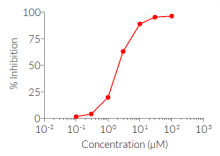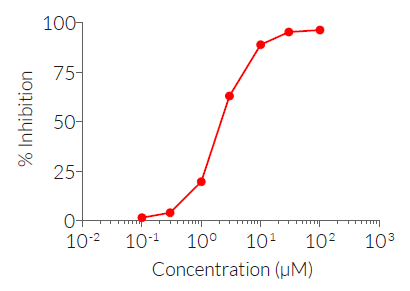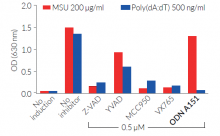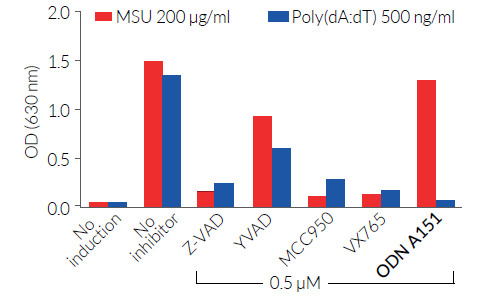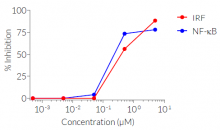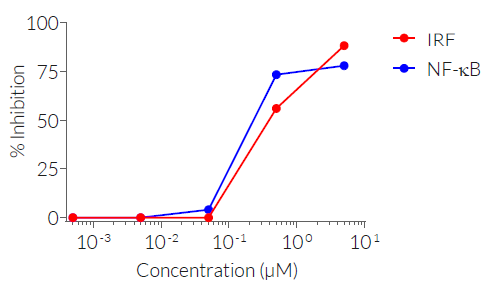ODN TTAGGG (A151)
| Product | Unit size | Cat. code | Docs. | Qty. | Price | |
|---|---|---|---|---|---|---|
|
ODN TTAGGG (A151) TLR9 antagonist - Human preferred |
Show product |
200 µg 1 mg |
tlrl-ttag151
|
|
Suppressive oligonucleotide - TLR9, AIM2, and cGAS antagonist
ODN TTAGGG (A151), also known simply as A151, is a synthetic oligonucleotide (ODN) containing 4 consecutive repeats of the immunosuppressive TTAGGG motif commonly found in mammalian telomeric DNA [1].
Initially, this ODN was identified as a TLR9 antagonist that inhibits immune activation by CpG-containing ODNs [2].
Subsequently, the cytosolic DNA sensors (CDSs) AIM2 and IFI16 were identified as additional targets for ODN TTAGGG (A151). By binding to these CDSs, ODN TTAGGG (A151) prevents AIM2 inflammasome activation [3,4].
This ODN is also described as a cGAS inhibitor, acting through competition with DNA [1].
Overall, these findings show that ODN TTAGGG (A151) is a multiple pattern recognition receptor (PRR) suppressor that can prove useful for immunomodulatory studies.
Key features of ODN TTAGGG (A151):
- ODN containing 4 repeats of TTAGGG
- TLR9, AIM2, and cGAS antagonist
- Each lot is functionally tested
![]() Read our review on cGAS.
Read our review on cGAS.
References:
1. Steinhagen F. et al., 2017. Suppressive oligodeoxynucleotides containing TTAGGG motifs inhibit cGAS activation in human monocytes. Eur J Immunol. DOI: 10.1002/ eji.201747338.
2. Gursel I. et al., 2003. Repetitive elements in mammalian telomeres suppress bacterial DNA-induced immune activation. J Immunol. 171(3):1393-400.
3. Eichholz K. et al., 2016. Immune-Complexed Adenovirus Induce AIM2-Mediated Pyroptosis in Human Dendritic Cells. PLoS Pathog. 12(9):e1005871.
4. Kaminski J. et al., 2013. Synthetic oligodeoxynucleotides containing suppressive TTAGGG motifs inhibit AIM2 inflammasome activation. J Immunol. 191(7):3876-83.
Specifications
Working concentration: 100 nM - 10 µM
Solubility: 5 mg/ml in water
Molecular weight: 7944 g/mol
ODN TTAGGG sequence
5’- tt agg gtt agg gtt agg gtt agg g -3’ (24 mer)
Note: Bases are phosphorothioate-linked (nuclease resistant).
Quality control:
- Biological activity has been tested using HEK-Blue™ TLR9 cells.
- The absence of bacterial contamination (e.g. lipoproteins and endotoxins) has been confirmed using HEK-Blue™ TLR2 and HEK-Blue™ TLR4 cells.
Contents
ODN TTAGGG (A151) is provided lyophilized and is available in two quantities.
tlrl-ttag151:
- 200 μg (25.2 nmol) lyophilized ODN TTAGGG (A151)
- 1.5 ml endotoxin-free water
tlrl-ttag151-1:
- 1 mg (126 nmol) lyophilized ODN TTAGGG (A151)
- 1.5 ml endotoxin-free water
![]() ODN TTAGGG (A151) is shipped at room temperature.
ODN TTAGGG (A151) is shipped at room temperature.
![]() Upon receipt, store at -20 °C.
Upon receipt, store at -20 °C.
Details
Toll-like receptor 9
The Toll-like Receptor 9 (TLR9) is an endosomal receptor that triggers NF-κB- and interferon regulatory factor (IRF)-mediated pro-inflammatory responses upon the recognition of unmethylated cytosine-phosphorothioate-guanosine (CpG) forms of DNA [1-3]. Unmethylated CpG dinucleotides are a hallmark of microbial (bacterial, viral, fungal, and parasite) DNA, as well as mitochondrial self-DNA [3,4]. These TLR9 agonists can be mimicked by synthetic oligonucleotides containing CpG motifs (CpG ODNs), which have been extensively studied to improve adaptive immune responses in the context of vaccination [1,3].
AIM2 Inflammasome
AIM2 (absent in melanoma 2), a receptor for cytoplasmic DNA, forms an inflammasome with its ligand and ASC to activate caspase-1 [5-7]. AIM2 is an interferon-inducible HIN-200 family member that contains an amino-terminal pyrin domain and a carboxy-terminal oligonucleotide/oligosaccharide-binding domain. AIM2 senses cytoplasmic double-stranded DNA through its oligonucleotide/oligosaccharide-binding domain and interacts with ASC via its pyrin domain to activate caspase-1. The interaction of AIM2 with ASC also leads to the formation of the ASC pyroptosome, which induces pyroptotic cell death in cells containing caspase-1. AIM2 is necessary and sufficient for inflammasome activation in response to cytoplasmic DNA.
cGAS
Cyclic GMP-AMP synthase (cGAS, cGAMP synthase) is a critical cytosolic DNA sensor that triggers innate immune responses through the production of type I interferons (IFNs) [8]. In response to cytosolic double‑stranded DNA (dsDNA), cGAS produces the cyclic dinucleotide (CDN) 2’3’-cGAMP.
CDNs bind directly to STING, leading to TBK1‑IRF3-mediated activation of IFN-stimulated response elements (ISRE) in the promoters of IFN-stimulated genes (ISG). The most potent agonist of human STING is 2’3’-cGAMP [9,10].
References:
1. Kumagai Y. et al., 2008. TLR9 as a key receptor of the recognition of DNA. Adv. Drug. Deliv. Rev. 60(7):795-804.
2. Heinz L.X. et al., 2021. TASL is the SLC15A4-associated adaptor for IRF5 activation by TLR7-9. Nature. 581(7808):316-322.
3. Kayraklioglu N. et al., 2021. CpG oligonucleotides as vaccine adjuvants. DNA Vaccines: Methods and Protocols. Methods in Molecular Biology. Vol. 2197. p51-77.
4. Kumar V., 2021. The trinity of cGAS, TLR9, and ALRs: guardians of the cellular galaxy against host-derived self-DNA. Front. Immunol. 11:624597.
5. Hornung V. et al., 2009. AIM2 recognizes cytosolic dsDNA and forms a caspase-1-activating inflammasome with ASC. Nature. 458(7237):514-8.
6. Fernandes-Alnemri T. et al., 2009. AIM2 activates the inflammasome and cell death in response to cytoplasmic DNA. Nature.458(7237):509-13.
7. Bürckstümmer T. et al., 2009. An orthogonal proteomic-genomic screen identifies AIM2 as a cytoplasmic DNA sensor for the inflammasome. Nat Immunol. 10(3):266-72.
8. Sun L. et al., 2013. Cyclic GMP-AMP synthase is a cytosolic DNA sensor that activates the type I interferon pathway. Science 339(6121):786-91.
9. Gao P. et al., 2013. Cyclic [G(2’,5’)pA(3’,5’)p] is the metazoan second messenger produced by DNA-activated cyclic GMP-AMP synthase. Cell. 153(5):1094-107.
10. Ablasser A. et al., 2013. cGAS produces a 2’-5’-linked cyclic dinucleotide second messenger that activates STING. Nature. 498(7454):380-4.





